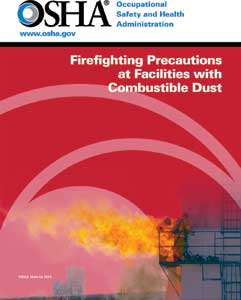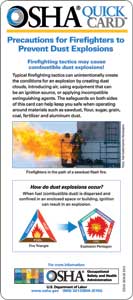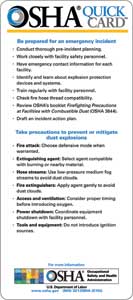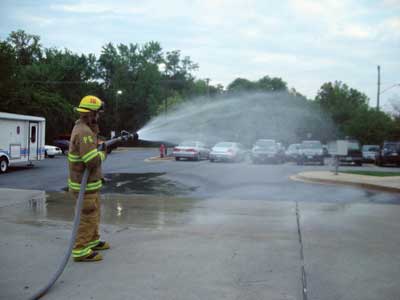BY MAT CHIBBARO
When you hear the term “combustible dust,” what image enters your mind? For some, it’s a smoldering pile of dust, hardly an imminent hazard as most emergency incidents go. But let’s think about this a minute. If that pile of dust is tossed into the air and ignited, you can be faced with a flash fire or an explosion. Even small flash fires are rapid-combustion events, so rapid that you would not be able to outrun them. If the amount of dust is large, you have a potential for a major incident. Secondary explosions can occur as more dust is released or disturbed.
Traditional firefighting tactics can get you into trouble very fast when combustible dusts are present, whether involved in fire or located nearby. Keeping your firefighters safe when operating at incidents involving or near combustible dust requires advance planning, careful strategy and tactics during an incident, and some technical expertise regarding the properties of the combustible material.
Fire protection engineers with the U.S. Occupational Safety and Health Administration (OSHA) have developed two products to assist firefighters facing these hazards. The first is a detailed manual (Figure 1) that treats the subject comprehensively. It includes a primer on how combustible dust flash fires and explosions occur, case studies of incidents that resulted in firefighter deaths and injuries, methods of preincident planning, and specific firefighting precautions. The National Institute for Occupational Safety and Health (NIOSH) has investigated several firefighter fatality incidents involving combustible dust. Some of them are summarized in the OSHA manual, as are other incidents including the flash fire shown on the cover of the manual in Figure 1, which enveloped two firefighters.
| Figure 1. |
 |
| Figure 1. Occupational Safety and Health Administration Manual. |
The second OSHA product aimed at educating firefighters on dust explosions is a double-sided quick card (Figures 2 and 3). The card summarizes the major points of the full manual to help keep you safe. It is intended to serve as a rapid reference or a quick refresher you can use for training, while en route to an incident, or when operating at an incident scene. The manual and the quick card are available free on OSHA’s Web site, as is a Web page dedicated to combustible dust hazards (see links at the end of the article). The knowledge you need to keep you from getting into situations like this is at your fingertips in the material published by OSHA and NIOSH.
| Figure 2 and Figure 3 |
 |
 |
| Figures 2, 3. The front and back of the OSHA Quick Card. |
PLANNING FOR RESPONSE
The following is a list of considerations you should bear in mind when you are faced with the potential for such an incident in your response area; it is condensed from the Quick Card:
- Preincident planning. Conducting preincident planning and developing an incident action plan that incorporates combustible dust-specific precautions will go a long way in keeping firefighters safe. You do not want to inadvertently make a situation worse, which will be embarrassing at the least even if no injuries occur. The protection features and procedures to handle these hazards are often very specific to each facility. When firefighters work with facility personnel to learn about combustible dust hazards and how to effectively plan for and mitigate an incident, safety is increased for firefighters and workers. Maintaining emergency contact numbers for key plant personnel can also pay off during an incident.
- Tactical decisions. One of the first tactical decisions during any emergency incident is determining whether to make entry into a structure to attack a fire or to focus largely on exterior defensive operations. This decision is critical during responses that involve combustible dusts because a relatively minor incident can transition to a flash fire or an explosion with little or no warning. You could also be fooled into assuming there is no structural damage if a flash fire is extinguished before your arrival.
- Selecting an extinguishing agent. We all understand the importance of selecting an extinguishing agent. This is complicated during combustible dust incidents because there may be multiple types of fuels involved or near enough to be of concern. The quantity of extinguishing agent must also be sufficient before beginning the extinguishment process.
-
Applying agent. When using extinguishers or hose streams, applying an agent is a key consideration. Straight streams may disperse dust, and wide fog streams can entrain a large amount of air; either can create an explosible dust cloud. Assuming firefighters can safely get close enough, gentle application is a good rule of thumb. Hose streams with a medium fog stream at low pressure (photo 1) will likely be best if water or foam is the appropriate agent. Fog nozzles that can be used at low pressures without reducing flow are advantageous.

(1) This firefighter is demonstrating the use of a low-pressure medium fog stream. Full personal protective equipment, including self-contained breathing apparatus, and backup personnel, of course, would be needed during emergency operations. (Photo by author.) - Installed suppression systems. A good understanding of installed fire and explosion suppression systems is important. Systems designed for fires will likely be ineffective to protect against flash fires or explosions. Facilities with combustible dust hazards may employ specialized systems or devices for preventing fires and explosions, detection, protection, venting, or suppression. A safe and successful outcome requires a clear understanding of these specialized (and often unique) features before interacting with them.
- Access and ventilation. Gaining access and ventilation are two traditional firefighting tactics. At combustible dust incidents, if done improperly, these actions can result in sudden release of material or sudden introduction of air. Either can result in an explosible dust cloud where none existed prior to your action. It is important, therefore, to thoroughly understand the ramifications of accessing or ventilating and to consider the proper timing of such actions in a well-coordinated manner. Consulting with the plant’s emergency contacts can help determine the safest procedure.
- Power shutdown. Firefighters commonly shut down sources of power early in an incident. Here again, responders must ensure that power shutdown is the appropriate course of action, or they must at least consider the proper timing of the shutdown. Understanding all the implications of power shutdown can be important. For example, some dust collectors will release dust from filters when power is cut, allowing a dust cloud to form. Power shutdown is, therefore, another tactic requiring coordination with facility personnel.
TECHNICAL KNOWLEDGE
Combustible dust hazards and incidents can require considerable technical knowledge. Many variable factors affect the explosibility of combustible dust, including chemical composition, particle size and shape, particle surface area-to-volume ratio, how well particles stick together (known as “agglomeration”), moisture content, impurities present, particle concentration and distribution in a dust cloud, turbulence, and the location and strength of the ignition source. As a result, the ignition of a combustible dust cloud is much less predictable than a vapor-air mixture. A fire protection engineer can provide technical assistance to your fire department in several ways—for example, in planning before an incident, serving as a liaison between the department and the facility, and serving perhaps as a technical advisor during an incident.
Author’s note: You can download OSHA’s manual at www.osha.gov/Publications/OSHA_3644.pdf. The Quick Card can be downloaded at www.osha.gov/Publications/OSHA_3674.pdf. General information on combustible dust hazards is available at www.osha.gov/dsg/combustibledust/index.html. Review NIOSH firefighter fatality reports at www.cdc.gov/niosh/fire. For a sample job description of a fire protection engineer, visit http://www.sfpe.org > About Us > Committees & Task Groups > Fire Service Committee.
Disclaimer: The views expressed in the article are the personal views of the author and do not purport to reflect official views of OSHA or the U.S. Department of Labor.
MAT CHIBBARO, PE, CSP, is a fire protection engineer with the Occupational Safety and Health Administration National Office in Washington, D.C.; a part-time assistant with the Gaithersburg (MD) Fire Marshal’s Office; and an adjunct faculty member with the University of Maryland’s Fire Protection Engineering Department. He serves on a number of National Fire Protection Association technical committees and the Society of Fire Protection Engineers’ Fire Service Committee. He is a licensed P.E. in fire protection in California and Maryland, has 32 years of experience in fire code application and enforcement (mainly at the local level), and has served 39 years in the volunteer fire and rescue service (primarily in Prince George’s County, Maryland).
Fire Engineering Archives

